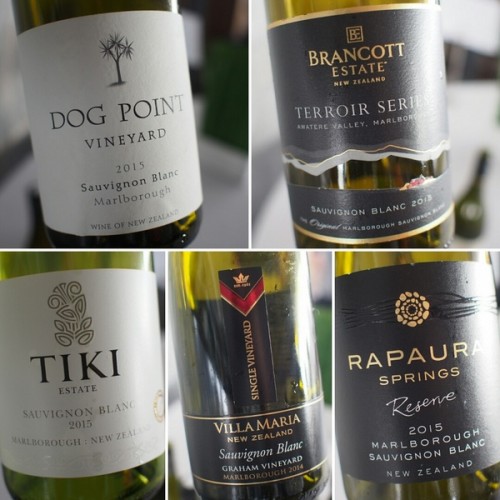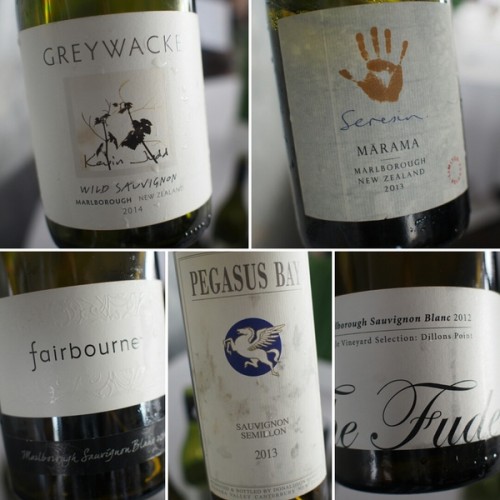
Yesterday I took part in a New Zealand Sauvignon Blanc seminar at New Zealand House in London. The aim of the seminar was to compare classic styled Marlborough Sauvignon Blanc with newer alternative styles, such as those that are barrel fermented, or fermented using wild yeasts.
My job was to make the case for the classic styles, and Melanie Brown of New Zealand Cellar was tasked with defending the newer, more experimental styles of Sauvignon. We had five wines each, and as well as tasting them, we had a broad-ranging discussion about Sauvignon, expertly chaired by Patrick Schmitt of The Drinks Business.
My point? Since the first vines went into the ground in Marlborough in 1973, this region has experienced amazing success. Now, with 22 000 hectares under vine, it’s the country’s largest region by far, and this success has been built on Sauvignon Blanc. Marlborough Sauvignon is a unique style that has won the hearts of wine lovers worldwide. It combines well integrated green aromas and tastes with lovely fruity aromatics: think passionfruit, grapefruit, tomato leaf, green pepper, lemons and gooseberries (if you know what these are).
The classic style of Marlborough Sauvignon has redefined this grape variety, and it has put New Zealand on the map. When people buy a bottle of wine that says New Zealand Sauvignon Blanc, they know what to expect, and the consistency of these wines has seen Kiwi wine get the highest per bottle average price in the UK by some distance, compared with other countries.
So don’t fix what isn’t broken. By introducing new and esoteric styles of Sauvignon, there’s a danger that consumers will be confused.
Melanie countered very well, and began by asking me what I thought of the alternative styles. My answer? I love them. I think that there are now some brilliant alternative Sauvignons coming from New Zealand: not relying on overt greenness and thiol lift for their impact, but having more texture, complexity and ageworthiness. I’m excited to see these styles. But I’m a geek, not the average consumer. She made a good argument that there’s room in the marketplace for these wines, and that she sells them to her customers all the time. Given the right communication to customers, these alternative wines add an extra facet to the New Zealand wine offering. They also represent a chance to break the price ceiling that exists for Marlborough Sauvignon made in the classic unoaked style.
We agree, I guess. There’s a place for the classic style (and these wines seem to be improving each year), but there’s also a place for alternative styles, too. It’s an exciting time for New Zealand wine, and Sauvignon is anything but boring.
The classics
Rapaura Springs Reserve Sauvignon Blanc 2015 Marlborough, New Zealand
Blend of Wairau, Rapaura and Awatere. Pungent green herbal nose with grassy green pepper notes. Lively and focused on the palate with broad texture and sweet melon and pear fruit. Textured and smooth, this is aromatic and polished with lovely weight. 91/100
Tiki Estate Sauvignon Blanc 2015 Wairau Valley, Marlborough, New Zealand
From upper Wairau. Fresh grapefruit and lemon nose with some passionfruit aromatics. Lively, bright, crisp and balanced with bright limey notes. Very pretty and balanced with some tropical notes but also citrus freshness. Pure. 91/100
Dog Point Sauvignon Blanc 2015 Wairau Valley, Marlborough, New Zealand
Lovely tension here between the fresh grapefruit and lemony flavours, and the detailed spice and passionfruit notes. Has detail and precision, with lovely freshness. Really classic and showing nice complexity. 93/100
Brancott Estate Terroir Series Sauvignon Blanc 2015 Awatere Valley, Marlborough, New Zealand
Lovely green tomato leaf and green pepper nose. It’s very green but it is well integrated with the fruity aromas. Vivid, green palate with some pear and melon richness and superbly integrated greenness. 92/100
Villa Maria Single Vineyard Graham Sauvignon Blanc 2014 Awatere Valley, Marlborough, New Zealand
Pungent and melony with some pear and citrus as well as a slight waxy edge. Nicely textural with appealing green notes well integrated into the rich melony fruit. Generous and delicious with some saline, mineral, chalky notes adding interest. 92/100

The alternatives
Fairbourne Sauvignon Blanc 2014 Marlborough, New Zealand
3 hectares, north facing slope. Slightly smoky edge to the tangerine and pear note. 3% of blend fermented in French oak. Some subtle toast here, too with ripe fruit. 89/100
Greywacke Wild Sauvignon 2014 Marlborough, New Zealand
Complex fig and herb notes on the nose with peach and fine citrus characters. Aromatic and quite intense. The palate is bold and generous with complex pear, peach and spice notes. Full flavoured and with potential for development. 93/100
Seresin Mārama Sauvignon Blanc 2013 Marlborough, New Zealand
Complex and broad with toast, nuts and pears and well as some spicy, waxy complexity. Bold and intense with lovely depth of flavour: it’s just so well integrated with a strongly savoury dimension and potential for development. 93/100
Giesen The Fuder Dillons Point Sauvignon Blanc 2012 Marlborough, New Zealand
Complex and intense with striking notes of green herbs, peppers and quince coupled with toast, nuts and spice. Lively lemony acidity keeps things fresh. Has depth to it, and a really broad spectrum of flavours. The toastiness is really prominent at the moment, but I think this will harmonize in time. 91/100
Pegasus Bay Sauvignon Semillon 2013 Waipara Valley, New Zealand
Lovely balance here between the fresh, citrus and green flavours and the more broad peach and subtle toast notes. Really inviting with a sweet fruity quality and subtle green notes. Has lovely balance and the potential for development. 92/100
Find these wines with wine-searcher.com
See also: Older New Zealand Sauvignon Blanc: can it age? Should we cellar it?
5 Comments on New Zealand Sauvignon Blanc Seminar: classic versus alternative styles
Bang on; consumers that taste the newer barrel/wild (often both) styles aren’t so much confused, as outright don’t like them as much as those classic styles they’re used to. And from experience, they’re not too bothered about learning about “wild” fermentation, strangely enough.
The winemakers know this too; the volume of classic styles versus newer styles must be greater than than 9:1 I bet.
So I guess most drinkers won’t be confused, because they’ll not either encounter them nor stump up the extra cash to try them.
However, the newer styles definitely hit the right notes with the somm/on-trade market, much more “food-friendly” and maybe that’s their future (or even intended?) market?
Nice alternative if one can find these new wave SBs.
Do no think these alternative wines will get much attention here though…pity.
Thanks for your comments Jamie.
Fairbourne available through Majestic Wine.
This has already started building up a bit of confusion around and generates an impression that classic ‘green’ sav blanc is the thing of past.
We produce a very complex Sauvignon Blanc (Coquina)2012 (94/100 Bob Campbell)and 2014 (91/100 Bob Campbell) that has components of wild yeast, barrel ferment,skin contact (hand destemmed!),and stainless steel ferment.Lime Rock is situated on limestone hills in Central Hawke’s Bay NZ but has a similar climate to Marlborough.Available from OW Loeb in UK.